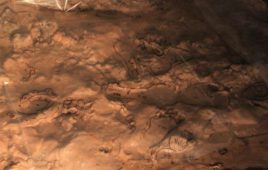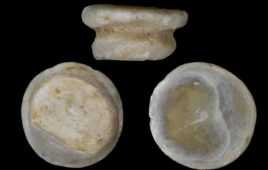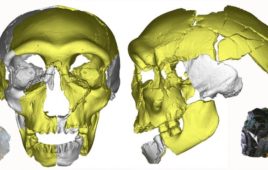
Volgatitan simbirskiensis anterior caudal vertebra (holotype), in right lateral (A), anterior (B), left lateral (C), posterior (D), dorsal (E), and ventral (F) views; photographs. Credit: Alexander Averianov and Vladimir Efimov
The Volgatitan has now joined the ranks of dinosaurs in the Sauropod family.
Paleontologists from the Akson Russian Science Communication Association have gathered together the final puzzle pieces for a new dinosaur from seven caudal vertebrae bones that had remained in the ground for the last 130 million years on the banks of the Volga River in Russia.
Sauropods are giant herbivorous dinosaurs with long necks and tails that lived on Earth about 200 to 65 million years ago. The massive Volgatitan dinosaur weighs an estimated 17 tons.
The bones likely belonged to an adult dinosaur because of its neural arches—the parts of the vertebrae protecting the nerves and blood vessels, which completely merged with the bodies of the vertebrae.
“The new taxon is characterized by strongly procoelous anterior and middle caudal vertebrae, a long centrum of the first caudal vertebra, a strong ventral ridge in the anterior and middle caudal vertebrae, a neural arch positioned at the anterior half of the centrum, hyposphene-hypantrum articulation in the anterior caudal vertebrae, and somphospondylous bone texture,” the researchers write in the study.
The remains of the dinosaur was discovered near the village of Slantsevy Rudnik, where in 1982 three large vertebrae were discovered after falling out of a high cliff. Then, between 1984 and 1987, three nodules of limestone containing the remaining vertebrae fell off the same cliff.
Along with the newly minted Volgatitan, 12 other valid dinosaur taxa in Russia have been recently described, three of which are Sauropods—Tengrisaurus starkovi, Sibirotitan astrosacralis and Volgatitan simbirskiensis.
Tengrisaurus starkovi and Sibirotitan astrosacralis represent the first two sauropods in Russia.
According to Aleksandr Averianov, a professor at St. Petersburg University, the description of dinosaur taxa in recent years has become possible due to the progress in understanding the anatomy and phylogeny of dinosaurs. The researchers were also able to learn more about how Sauropods had lived and developed.
“Previously, it was believed that the evolution of titanosaurs took place mainly in South America with some taxa moving into North America, Europe and Asia only in the Late Cretaceous,” Averianov said in a statement. “In Asia, representatives of a broader group of titanosauriform, such as the recently described Siberian titanium, dominated in the early Cretaceous.
“However, the recent description of the Tengrisaurus from the Early Cretaceous of Transbaikal Region and the finding of the Volgatitan indicate that titanosaurs in the Early Cretaceous were distributed much more widely; and, perhaps, important stages of their evolution took place in Eastern Europe and Asia,” he added.
The study was published in Biological Communications.




